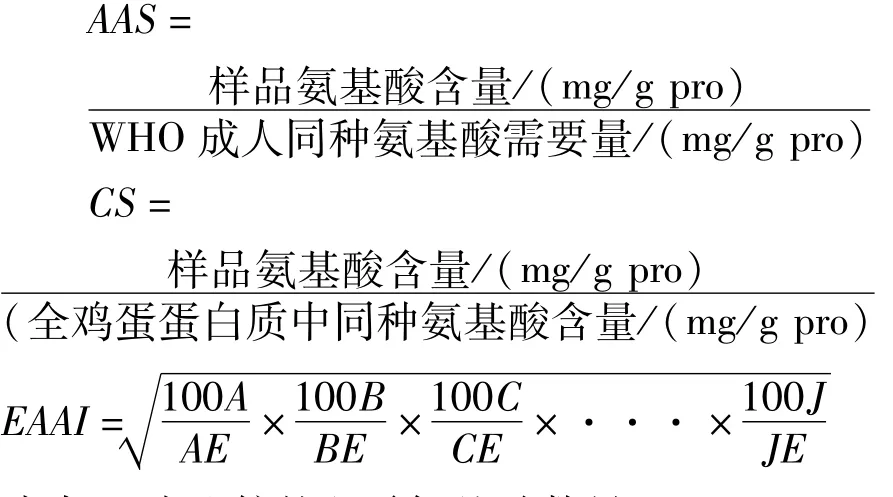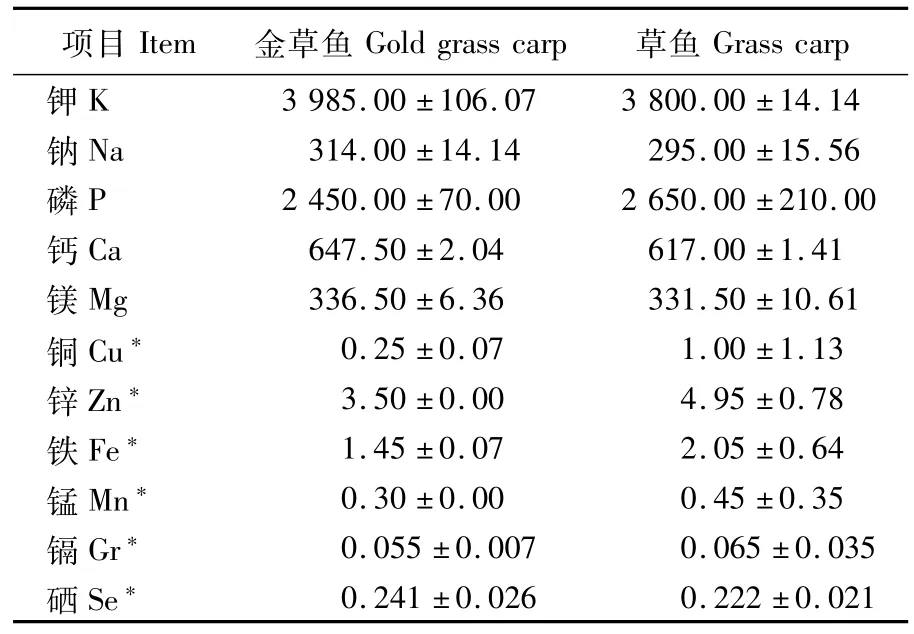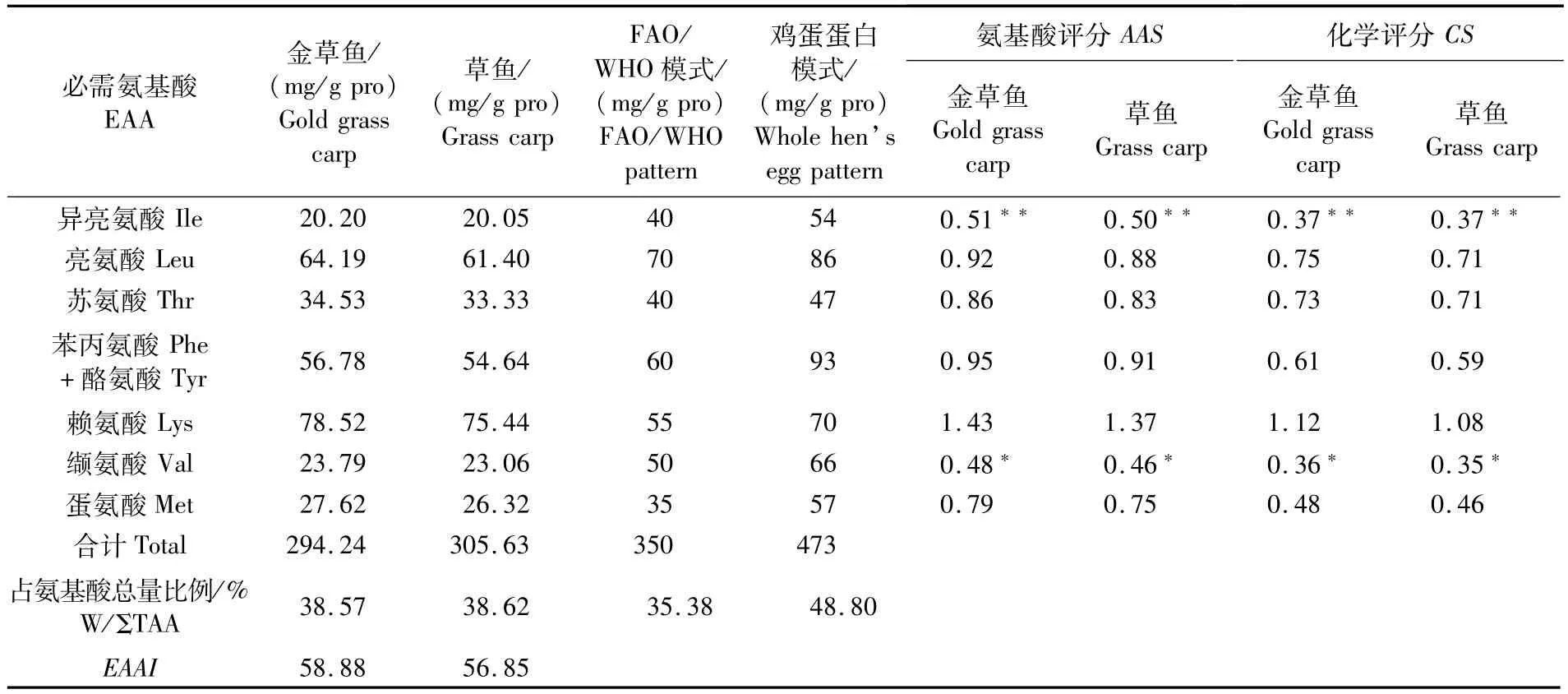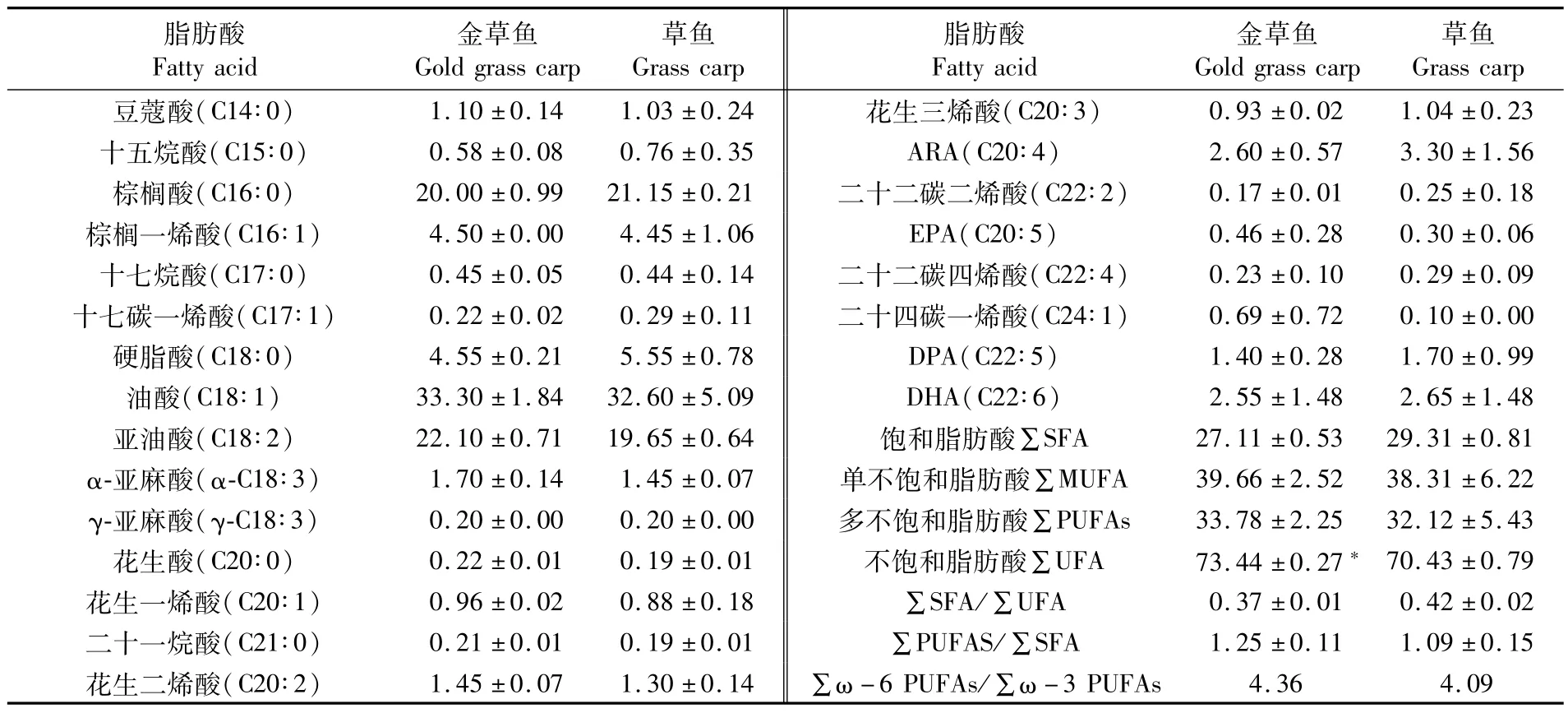金草鱼肌肉品质和营养成分分析及评价
2017-11-07樊佳佳白俊杰马冬梅李胜杰
朱 冰,樊佳佳,白俊杰,姜 鹏,马冬梅,李胜杰
金草鱼肌肉品质和营养成分分析及评价
朱 冰1,2,樊佳佳1,白俊杰1,姜 鹏1,马冬梅1,李胜杰1
(1.中国水产科学研究院珠江水产研究所,农业部热带亚热带水产资源利用与养殖重点实验室,广州 510380;2.上海海洋大学水产与生命学院,上海 201306)
为了评价金草鱼(Ctenopharyngodon idellus)肌肉品质和营养成分,对同塘养殖的金草鱼和普通草鱼肌肉品质和营养成分进行比较分析及评价。结果显示:金草鱼和草鱼的含肉率分别为70.57%和73.13%,肌肉水分含量分别为78.60%和78.40%,粗蛋白含量分别为19.55%和19.95%,粗灰分含量分别为1.80%和1.45%,粗脂肪含量分别为0.39%和0.50%。金草鱼肌肉的冷冻渗出率和蒸煮失重率低于草鱼,贮存损失为2.64%,显著低于草鱼的4.87%。金草鱼肌肉系水力大于草鱼,保水性更好。金草鱼与草鱼肌肉中氨基酸组成合理,必需氨基酸含量丰富,分别为5.45%和5.35%,必需氨基酸/总氨基酸分别为35.16和35.21,必需氨基酸指数为58.88和56.85;不饱和脂肪酸含量丰富,分别占总脂肪酸的73.44%和70.43%。综合分析表明,金草鱼与草鱼均为高蛋白、低脂肪的食品,具有较高的营养价值。金草鱼肌肉的系水力、必需氨基酸含量和不饱和脂肪酸含量大于草鱼。
草鱼;肌肉;含肉率;系水力;营养评价
金草鱼(Ctenopharyngodon idellus)又名金丝鲩、俄罗斯金草鱼等,隶属鲤形目(Cypriniformes),鲤科(Cyprinidae)、雅罗鱼亚科(Leuciscinae)、草鱼属,是20世纪90年代佛山市顺德区农业水产站从日本转道俄罗斯引进我国,目前主要养殖于我国广东和福建地区,它体表呈金黄色,形态体型与普通草鱼相似[1-2],引进后养殖规模逐渐扩大,除了食用外,还有一定的观赏作用。目前对金草鱼的研究主要集中在养殖技术[1-2]和种质资源方面[3],其养殖方式与普通草鱼相同,并有生长快、抗病力强等特点;在遗传结构上,金草鱼与我国养殖的普通草鱼差别较大,属于一个分支的地理种群[3]。有关金草鱼与草鱼在营养成分方面的差异还未见有报导,在肉质上金草鱼的肉质细嫩、味道鲜美,与草鱼有很大差别。本研究拟在肌肉品质和营养成分方面对金草鱼和草鱼进行分析和评价,以期为其养殖推广和生产加工提供理论依据。
1 材料与方法
1.1 实验材料
金草鱼亲本取自南海通威水产科技有限公司,草鱼亲本取自中国水产科学研究院珠江水产研究所高要基地,在2015年5月,两批草鱼进行群体内交配繁殖,在鱼苗3 cm时同塘混养,全程投喂人工配合饲料。2016年7月各挑选5 ind用于实验,实验前禁食1 d,金草鱼和草鱼的平均体质量分别为(1 385.1±151.9)g和(1 406.0±123.6)g。
1.2 含肉率的测定
参考黄峰等[4]的方法测定含肉率,鱼体擦干后,测量其体质量(W1),分别去除血液、鳃、鳞片、皮肤和内脏后称质量(W2),然后放入蒸锅内蒸至肉和骨骼完全分离,去除肌肉等可食部分,洗净骨骼和鳍条,滤纸吸干后称质量(W3)。含肉率的计算公式:

1.3 pH值的测定
参考赵亮[5]的方法测定pH,取背部白肌5 g,剪碎后放入匀浆管,加45 mL蒸馏水,置于冰上匀浆后静置10 min,然后用pH计(Mettler Toledo PE-20)测定pH值,每尾鱼取3个样,每个样重复测定3次。
1.4 肌肉系水力的测定
选取背部白肌,首先将肌肉切成大小适当方块,每个方块质量约5 g左右,每尾鱼选取3个肌肉方块,用滤纸吸干表面水分后准确称质量,然后分别放入自封袋,一份放入4℃冰箱中24 h后取出用滤纸吸干表面水分后称质量;一份放入-20℃冰箱中24 h后取出待解冻后用滤纸吸干表面水分后称质量;一份放入沸水中煮5 min,滤纸吸干表面水分后称质量;根据质量的变化计算肌肉的贮存损失、冷冻渗出率和蒸煮失重率[6]。
1.5 常规营养成分及矿物元素测定
分别采用直接干燥法(GB 5009.3—2010/第一法)测定水分;重量法(GB 5009.4—2010)测定灰分;索氏提取法(GB/T 5009.6—2003/第一法)测定粗脂肪;凯氏定氮法(GB 5009.5—2010/第一法)测定粗蛋白。火焰发射光谱法测定钾(K)和钠(Na)(GB/T 5009.91-2003);分光光度法测定磷(P)(GB/T 5009.87-2003/第一法);原子吸收分光光度法测定钙(Ca)(GB/T 5009.92-2003)、铁(Fe)、锰(Mn)和镁(Mg)(GB/T 5009.90-2003);原子吸收光谱法测定锌(Zn)(GB/T 5009.14-2003/第一法)和铜(Cu)(GB/T 5009.13-2003/第一法 火焰法);氢化物原子荧光光谱法测定硒(Se)(GB 5009.93-2010/第一法)。氨基酸和脂肪酸的组成和含量参照GB/T 18654.11-2008、GB/T 9695.2-2008的方法进行测定。样品重复测定3次。
1.6 营养品质评价
根据联合国粮农组织/世界卫生组织(WHO/FAO)1973年建议的氨基酸评分标准模式[7]和全鸡蛋蛋白质的氨基酸模式[8],分别按以下公式计算氨酸酸评分(AAS)、化学评分(CS)以及必需氨基酸指数(EAAI)[9]:

式中:n为比较的必需氨基酸数量;A、B、C···J为草鱼肌肉蛋白质中必需氨基酸的含量/(mg/g pro);AE、BE、CE···JE为全鸡蛋蛋白质中同种氨基酸含量/(mg/g pro)。

1.7 数据处理
采用Excel 2010软件处理实验数据,用SPSS 17.0软件的单因素方差(One-way ANOVA)分析模块对数据进行显著性检验。
2 结果与分析
2.1 肌肉品质和一般营养成分
金草鱼与草鱼的主要品质及营养指标见表1,从表1可知:金草鱼肌肉的pH和水分略高于草鱼;粗蛋白、粗脂肪、贮藏损失和蒸煮失重率略低于草鱼,但差异均不显著(P>0.05)。灰分、含肉率和冷冻渗出率显著低于草鱼(P<0.05)。金草鱼的贮存损失、冷冻渗出率和蒸煮失重率均低于草鱼,其中冷冻渗出率显著低于草鱼(P<0.05),由此可知金草鱼肌肉的系水力更好。
2.2 矿物质元素含量
所检测的矿物元素见表2,共检测了5种常量元素和6种微量元素,常量元素中含量由高到低依次为钾、磷、钙、镁和钠,微量元素中含量最高的是锌,含量最低的是铬。金草鱼与草鱼之间无论是常量元素还是微量元素差异均不显著(P>0.05)。

表1 金草鱼与草鱼的品质及营养指标Tab.1 Quality and nutrition components of gold grass carp and grass carp

表2 金草鱼和草鱼肌肉中的矿物元素含量(鲜样)Tab.2 Contents of mineral elements in the muscle of gold grass carp and grass carp(fresh)(mg·kg-1)
2.3 氨基酸组成
金草鱼与草鱼肌肉氨基酸组成见表3,研究中采用酸水解法预处理样品,色氨酸(Typ)被水解破坏而未能检测出,共检测出16种氨基酸,分析结果显示,金草鱼与草鱼肌肉中各氨基酸含量差异均不显著(P>0.05),16种氨基酸中谷氨酸(Glu)含量最高,异亮氨酸(Ile)含量最低。金草鱼肌肉中必需氨基酸(EAA)含量、非必需氨基酸(NEAA)含量、呈味氨基酸(DAA)含量、总氨基酸(TAA)含量均略大于草鱼,但差异不显著(P>0.05)。金草鱼和草鱼肌肉中氨基酸总量分别为15.49%和15.20%,必需氨基酸占氨基酸总量的35.16%和35.21%,与非必须氨基酸的比值分别为64.55%和64.69%;呈味氨基酸分别占总氨基酸的42.16%和42.17%,差异均不显著(P>0.05)。

表3 金草鱼与草鱼肌肉中氨基酸组成及含量(鲜样)Tab.3 Composition and contents of amino acids in the muscle of gold grass carp and grass carp(fresh)(%)
2.4 肌肉营养价值评定
根据所测氨基酸含量及WHO/FAO建议的评分标准和全鸡蛋蛋白质评分标准,分别计算金草鱼和草鱼的必需氨基酸评分、化学评分和必需氨基酸指数值,结果见表4。结果表明金草鱼的氨基酸评分、化学评分和必需氨基酸指数值均大于草鱼。氨基酸评分和化学评分均显示,金草鱼和草鱼的第一限制性氨基酸是缬氨酸(Val),第二限制性氨基酸是异亮氨酸(Ile)。
2.5 脂肪酸组成
金草鱼和草鱼肌肉中的脂肪酸组成及含量见表5。金草鱼和草鱼肌肉中共检测出23种脂肪酸,其中饱和脂肪酸(SFA)7种,不饱和脂肪酸(UFA)16种,不饱和脂肪酸(UFA)中含有5种单不饱和脂肪酸(MUFA)和 11种多不饱和酸(PUFAs)。分析显示,除不饱和脂肪酸总量有显著差异外(P<0.05),其余均无显著性差异。金草鱼肌肉中饱和脂肪酸含量小于草鱼,单不饱和脂肪酸含量和多不饱和酸含量大于草鱼。

表4 金草鱼与草鱼肌肉必需氨基酸组成与评价Tab.4 Essential amino acids composition and evaluation in gold grass carp and grass carp

表5 金草鱼和草鱼肌肉中脂肪酸的组成及含量Tab.5 Composition and contents of fatty acids in the muscle of gold grass carp and grass carp (w,%)
3 讨论
3.1 含肉率
含肉率的计算中多采用可食部分(或肌肉)质量与体质量的比值[10-16],也有使用鱼肉质量与鱼体净质量的比值来计算[17-18]。鱼类含肉率的多少与体形、生长环境、饵料来源、规格和饱食程度等因素有关。本研究中,选取同塘养殖的金草鱼和草鱼,含肉率的差异可能是种类的特异性造成的。笔者通过对金草鱼和草鱼可量性状的测定发现,金草鱼的体长与体高的比值显著大于草鱼,体长与头长的比值显著小于草鱼,由此可以看出金草鱼的体形比草鱼更修长,头部所占比例更大,鱼体是肌肉生长的主要部位,因此金草鱼的含肉率比草鱼低与它们的体形存在较大差异有关。本研究中,用可食部分质量与体质量的比值计算含肉率,与使用同样方法测定草鱼[10]含肉率的结果相近(71.40%),与其它使用相同方法测定含肉率的 鱼 类 相 比,与 鲤 (Cyprinus carpio)[10](72.54%)、 翘 嘴 鲌 (Culter alburnus)[10](70.42%)相近,高于鳙(Aristichthys nobilis)[11](57.73%)、 华 鲮 (Sinilabeo rendahli)[12](60.65%)、匙 吻 鲟 (Polyodon spathula)[13](62.72%)和黄颡鱼 (Pelteobagrus fulvidsco)[4](67.53%),低于虹鳟(Oncorhynchus mykiss)[14](75.61%)、长 吻 鮠 (Leiocassis longirostris)[15](75. 69%)和 鳡 (Elopichthys bambusa)[16](77.61%)。
3.2 系水力
系水力是指肌肉通过自身的物理化学特性对水分的束缚能力,水分的流失会导致可溶性蛋白和可溶性风味物质的流失,也会造成有色物质的损失而影响肉色[19]。因此,系水力对肌肉的物理形态、风味、肉色等都有重要的影响。系水力的测定方法较多[20],本研究中采用贮存损失、冷冻渗出率和蒸煮失重率3种方法来测定系水力,可以对肌肉系水力进行较好的评价。肌肉系水力的大小与品种、特定基因型、年龄、体重、肌肉部位和饲养管理等因素有关,而影响肌肉系水力的本质取决于肌细胞的结构和完整性、蛋白质的空间结构[21],遗传上的基因突变会影响蛋白质的结构和功能进而影响相关生长特性[22],金草鱼与草鱼在遗传上的差异可能导致一些与肌肉系水力相关的蛋白在结构上存在差异,使得金草鱼的系水力更好。
3.3 肌肉营养成分
通过比较之前对草鱼肌肉一般营养成分的研究[23-27]发现,草鱼肌肉的一般营养成分变化较大,水分介于76.10%~81.02%之间,粗蛋白介于15.86% ~19.64%之间,粗脂肪介于 0.43% ~4.76%之间,对前人的实验材料分析可以发现,草鱼规格、饵料种类、生长环境、检测部位及检测方法等因素是造成营养成分变化较大的原因。本研究中金草鱼和草鱼的水分和粗蛋白在已研究的结果范围内,而金草鱼肌肉粗脂肪含量低于前人的研究结果,草鱼肌肉脂肪含量也不高,推测认为本研究中草鱼的检测部位不同是导致粗脂肪含量偏低的重要原因,王雪锋等[23]和别鹏等[25]选取的是背部肌肉与腹部肌肉混合后检测;李小勤等[27]选取的是背部肌肉检测,但是并未对取样部位进行详细说明。通过对鱼体不同部位的组织研究发现,腹部肌肉比背部肌肉具有更高的脂肪含量[28],鳙 (Aristichthys nobilis)[29]、奥 尼 罗 非 鱼(Oreochromis niloticus×O.aureus)[30]和尼罗罗非鱼(Oreochromis niloticus)[30]腹部肉脂肪含量分别是背部肉脂肪含量的2.86、7.53、5.83倍;对吉富罗非鱼(Oreochromis niloticus)[31]和泥鳅(Misgurni anguillicaudati)[32]的研究也发现,红肌的脂肪含量高于白肌,其中泥鳅红肌脂肪含量是白肌的1.44~2.98倍。去皮后的背部肌肉包含白肌和红肌等成分,因此肌肉组织的取样部位不同会导致实验结果存在差异。本研究中选取草鱼肌肉中含量最多的背部白肌为研究对象可能是造成脂肪含量偏低的主要原因。
蛋白质的质量通常使用氨酸酸评分(AAS)、化学评分(CS)以及必需氨基酸指数(EAAI)进行评价,参考标准主要是WHO/FAO标准模式和全鸡蛋蛋白质模式(1973)[34-35]。金草鱼在氨基酸组成、含量及比例上与草鱼均无明显差异,两者均含有丰富的必需氨基酸,根据FAO/WHO提出的蛋白参考模式,必需氨基酸含量应占氨基酸总量的40%左右,必需氨基酸与非必需氨基酸的比值应该大于0.6[33],金草鱼与草鱼肌肉氨基酸组成符合该标准。从氨基酸评分可以看出,金草鱼和草鱼肌肉必需氨基酸组成也基本满足WHO/FAO模式标准。鱼肉中含有较高的不饱和脂肪酸[36],不饱和脂肪酸对人有预防心脑血管病、降血脂、降血压、抑癌、抑过敏、抗炎和抗衰老等作用[37],金草鱼和草鱼肌肉中不饱和脂肪酸含量分别占脂肪酸总量的73.44%和70.43%,因此金草鱼和草鱼均是不饱和脂肪酸含量丰富的食品。
综上所述,金草鱼与草鱼都具有蛋白质含量高、必需氨基酸含量丰富、脂肪酸种类丰富、不饱和脂肪酸含量高等特点,都是营养价值高、味道鲜美的经济鱼类。其中金草鱼肌肉系水力高于草鱼,更适合加工和冷藏运输。
[1] 徐 保.金丝鲩鱼种培育技术初探[J].渔业致富指南,2013(20):61-62.
XU B.Gold grass carp fingerling rearing techniques[J].Fishery Guide to be Rich,2013(20):61-62.
[2] 胡大彬.俄罗斯金草鱼山区池塘养殖技术[J].福建农业,2013(9):31-31.
HU D B.Gold grass carp pond culture technology in mountain area[J].Fujian Agriculture,2013(9):31-31.
[3] 朱 冰,白俊杰,樊佳佳,等.金草鱼与中国4个草鱼群体的微卫星多态性比较分析[J].南方水产科学,2017,13(2):51-58.
ZHU B,BAI J J,FAN J J,et al.Gold grass carp microsatellite polymorphism and its comparative analysis with four grass carp populations from china[J].South China Fisheries Science,2017,13(2):51-58.
[4] 黄 峰,严安生.黄颡鱼的含肉率及鱼肉营养评价[J].淡水渔业,1999,29(10):3-6.
HUANG F,YAN A S.Evaluation of the mutrition and the rate of flesh in the whole body of Pelteobagrus fulvidraco rich[J].Freshwater Fisheries,1999,29(10):3-6.
[5] 赵 亮.南湾鳙鱼鱼肉品质特性研究[D].杨凌:西北农林科技大学,2012.
ZHAO L.Study on the meat quality characteristics of south bay bighead carp[D].Yangling:Northwest A&F University,2012.
[6] 马玲巧,李大鹏,田兴,等.1龄黄颡鱼的肌肉营养成分及品质特性分析[J].水生生物学报,2015,39(1):193-196.
MA L Q,LI D P,TIAN X,et al.The muscular nutritional components and flesh quality of farmed pelteobagrus fulvidraco yearlings[J]. Acta Hydrobiologica Sinica,2015,39(1):193-196.
[7] FAO/WHO Ad Hoe Expert Committee.Energy and protein requirements[M].Rome:FAO Nutrition Meeting Report Series,1973:52.
[8] 中国疾病预防控制中心营养与食品安全所.中国食物成分表2004(第2册)[M].北京:北京大学医学出版社,2004:142,234-235.
National Institute For Nutrition And Health Chinese Center For Disease Control And Prevention.China food composition2004(book 2)[M].Beijing:Peking University Medical Press,2004:142,234-235.
[9] PELLETT PL,YONG V R.Nutritional evaluation of protein foods[M].Tokyo:The United National University Publishing Company,1980:26-29.
[10] 王桂芹,孙 丽,李子平,等.不同食性鱼类的含肉率及肌肉营养组成与评价[J].饲料工业,2010,31(A01):94-98.
WANG G Q,SUN L,LI Z P,et al.Nutritional composition and evaluation in muscles and flesh content of various fishes with different feeding habits[J].Feed Industry,2010,31(A01):94-98.
[11] 王金娜,唐 黎,刘科强,等.人工养殖与野生鳙鱼肌肉营养成分的比较分析[J].河北渔业,2013(2):8-14.
WANG JN,TANG L,LIU K Q,et al.Analysis of nutritions in the muscle between cultured and wild variegated carp[J].Hebei Fisheries,2013(2):8-14.
[12] 张竹青,朱 玲,胡世然,等.人工配合饲料养殖华鲮的肌肉营养成分分析[J].水生态学杂志,2010,3(6):127-132.
ZHANG Z Q,ZHU L,HU SR,et al.The analysis on muscle nutrition component of Sinilabeo Rendahli cultivated by factitious combinative feed[J].Journal of Hydroecology,2010,3(6):127-132.
[13] 董宏伟,韩志忠,康志平,等.匙吻鲟含肉率及肌肉营养成分分析[J].淡水渔业,2007,37(4):49-51.
DONG H W,HAN Z Z,KANG Z P,et al.The nutritional composition and evaluation of muscle of Polyodom Spathula[J].Freshwater Fisheries,2007,37(4):49-51.
[14] 张昌吉,刘 哲,王世银.虹鳟含肉率及肌肉营养成分分析[J].水利渔业,2006,26(4):83-85.
ZHANG C J,LIU Z,WANG S Y.Analysis of nutritional composition and the rate of flesh in the whole body of Oncorhynchus mykiss[J].Reservoir Fisheries,2006,26(4):83-85.
[15] 张升利,孙向军,张 欣,等.长吻鮠含肉率及肌肉营养成分分析[J].大连海洋大学学报,2013,28(1):83-88.
ZHANG S L,SUN X J,ZHANG X,et al.The dressing rate and nutrient components in muscle of Leiocassis Iongirostris[J].Journal of Dalian Fisheries University,2013,28(1):83-88.
[16] 万松良,汪 亮,李 杰,等.鳡含肉率和肌肉营养成分分析[J].淡水渔业,2008,38(1):27-29.
WAN SL,WANG L,LI J,et al.Flesh content and nutritive composition of yellow cheek carp(Elopichthys bambusa)[J].Freshwater Fisheries,2008,38(1):27-29.
[17] 罗 青,陈昆慈,赵 建,等.乌鳢、斑鳢及其杂交F1代肌肉营养成分和含肉率的比较分析[J].大连海洋大学学报,2015,30(2):175-180.
LUO Q,CHEN K C,ZHAO J,et al.Dressed rates and muscular nutrients in northern snakehead Channa argus,Taiwan snakehead C.maculata and their hybrids[J].Journal of Dalian Fisheries University,2015,30(2):175-180.
[18] 陈永乐,刘毅辉,朱新平.3种塘鳢含肉率及肌肉营养成分分析与比较[J].广东海洋大学学报,2005,25(6):10-13.
CHEN Y L,LIU Y H,ZHU X P.Comparison and analysis of muscle nutrients and muscle contents of three kinds of goby in Eleotridae[J].Journal of Zhanjiang Ocean University,2005,25(6):10-13.
[19] 张玉伟,罗海玲,贾慧娜,等.肌肉系水力的影响因素及其可能机制[J].动物营养学报,2012,24(8):1389-1396.
ZHANG Y W,LUO H L,JIA H N,et al.Effect factors of water holding capacity of meats and its potential mechanism[J].Acta Zoonutrimenta Sinica,2012,24(8):1389-1396.
[20] ElMASRY G,SUN D W,ALLEN P.Non-destructive determination of water-holding capacity in fresh beef by using NIR hyperspectral imaging[J].Food Research International,2011,44(9):2624-2633.
[21] 周光宏.肉品加工学[M].北京:中国农业出版社,2009:130-132.
ZHOU G H.Meat processing[M].Beijin:China Agriculture Press,2009:130-132.
[22] 宋付标,昝林森,王洪程,等.秦川牛Chemerin基因第2和第6外显子的SNPs检测及其与肉质性状的相关性[J].西北农林科技大学学报(自然科学版),2011,39(3):1-7.
SONG F B, ZAN L S , WANG H C,et al.Polymorphism of chemerin gene and its relationship with meat quality traits in qinchuan cattle[J]Journal of Northwest A&F University(Natural Science Edition),2011,39(3):1-7.
[23] 王雪锋,涂行浩,吴佳佳,等.草鱼的营养评价及关键风味成分分析[J].中国食品学报,2014,14(12):182-189.
WANG X F,TU X H,WU J J,et al.Nutritional evaluation and analysis of the volatile flavor component of grass carp[J].Journal of Chinese Institute of Food Science and Technology,2014,14(12):182-189.
[24] 丁玉琴,刘友明,熊善柏.鳡与草鱼肌肉营养成分的比较研究[J].营养学报,2011,33(2):196-198.
DING Y Q,LIU Y M,XIONG SB.The comparative study on nutritional components between the muscle of Elopichthys bambusa and Ctenopharyngodon idellus[J].Acta Nutrimenta Sinica,2011,33(2):196-198.
[25] 别 鹏,时彦民,张 超,等.投喂蚕豆对草鱼生长及肌肉营养特性分析[J].水产养殖,2012,33(7):40-43.
BIE P,SHI Y M,ZHANG C,et al.Analysis of feeding broad bean on growth and flesh nutrition of grass carp Ctenopharyngodon idellus[J].Journal of Aquaculture,2012,33(7):40-43.
[26] 程汉良,蒋 飞,彭永兴,等.野生与养殖草鱼肌肉营养成分比较分析[J].食品科学,2013,34(13):266-270.
CHENG H L, JIANG F, PENG Y X, et al.Comparison of nutrient composition of muscles of wild and farmed grass carp,Ctenopharyngodon idellus[J].Food Science,2013,34(13):266-270.
[27] 李小勤,李星星,冷向军,等.盐度对草鱼生长和肌肉品质的影响[J].水产学报,2007,31(3):343-348.
LI X Q,LI X X,LENGX J,et al.Effect of different salinities on growth and flesh quality of Ctenopharyngodon idellus[J].Journal of Fisheries of China,2007,31(3):343-348.
[28] TESTI S,BONALDO A,GATTA PP,et al.Nutritional traits of dorsal and ventral fillets from three farmed fish species[J].Food Chemistry,2006,98(1):104-111.
[29] 姜启兴,吴佳芮,许艳顺,等.鳙鱼不同部位的成分分析及营养评价[J].食品科学,2014,35(5):183-187.
JIANG Q X,WU J R,XU Y S,et al.Composition analysis and nutritional evaluation of different parts of bighead carp (Aristichthys nobilis)[J]. Food Science,2014,35(5):183-187.
[30] 林婉玲,关 熔,曾庆孝,等.彩鲷和普通罗非鱼不同部位营养及质构特性的研究[J].现代食品科技,2011,27(1):16-21.
LIN WL,GUAN R,ZENGQ X,et al.Nutrition and textural properties of different parts of caidiao tilapia(Sarotherodon sp.) and common tilapia(Tilapia Nilotica Linnaeus)[J].Modern Food Science,2011,27(1):16-21.
[31] 穆小平,林小涛,朱志明,等.逆流运动及饲料脂肪水平对吉富罗非鱼生长和肌肉营养成分的影响[J].动物营养学报,2015,27(5):1411-1420.
MU X P,LIN X T,ZHU Z M,et al.Effects of upstream-swimming exercise and dietary lipid level on growth and muscle nutritional components of genetic improvement of farmed tilapia(Oreochromis niloticus)[J].Acta Zoonutrimenta Sinica,2015,27(5):1411-1420.
[32] 张 博,李书倩,辛 广,等.泥鳅不同部位脂肪酸的 GC-MS分析[J].食品科技,2013,38(4):313-316.
ZHANG B,LI SQ,XIN G,et al.Determination of fatty acid in different parts of Misgurni anguillicaudati by GC-MS[J].Food Science and Technology,2013,38(4):313-316.
[33] 李正中.花粉、灵芝与珍珠中必需氨基酸的定量测定与分析比较[J].氨基酸杂志,1988(4):41-42.
LI Z Z.Quantitative determination and analysis of essential amino acids infarina,Lucid Ganoderma and pear[J].Journal of Amino Acids Analysis,1988(4):41-43.
[34] SELIGSONFH,MACKEY L N.Variable predictions of protein quality by chemical score due to amino acid analysis and reference pattern[J].The Journal of Nutrition,1984,114(4):682-691.
[35] ADEYEYE E I.The comparison of the amino acids profiles of whole eggs of duck,francolin and turkey consumed in Nigeria[J].Global Journal of Science Frontier Research,2013,13(3):10-20.
[36] ÖZOGUL Y,ÖZOGUL F,ALAGOZ S.Fatty acid profiles and fat contents of commercially important seawater and freshwater fish species of Turkey:A comparative study[J].Food Chemistry,2007,103(1):217-223.
[37] SAHENA F,ZAIDUL ISM,JINAPS,et al.PUFAs in fish: extraction, fractionation, importance in health[J].Comprehensive Reviews in Food Science and Food Safety,2009,8(2):59-74.
Comparison and analysis of nutritional composition in gold grass carp and grass carp muscle
ZHU Bing1,2,FAN Jia-jia1,BAI Jun-jie1,JIANG Peng1,MA Dong-mei1,LI Sheng-jie1
(1.Key Laboratory of Tropical&Subtropical Fishery Resource Application&Cultivation,Ministry of Agriculture,Pearl River Fisheries Research Institute,Chinese Academy of Fishery Sciences,Guangzhou 510380;2.College of Fisheries and Life Science,Shanghai Ocean University,Shanghai 201306,China)
Grass carp Ctenopharyngodon idella is one of the commonest farmed fish species in China,and its production reached 5.67 million tons in 2015.Because of herbivory,easy rearing,fast growing and delicious taste,it has been introduced to 109 counties for aquaculture and biological control.Gold grass carp,a yellow strain of grass carp,had been introduced to China as a farming fish in the 1990s.Fujian and Guangdong are the key breeding provinces in China.At present,there are a few studies of gold grass carp in the growth and genetics,but no studies on nutrition.To improve the basic data of the quality and nutritional composition of the muscle in this species,the artificial propagation of gold grass carp and grass carp were bred in the same pond and fed artificial feed until reaching commodity specifications after 15 months,when gold grass carp reached 1.38kg and grass carp 1.40 kg.The gold grass carp and grass carp were selected respectively to do comparison analysis and evaluation by biochemical analysis method.The indexes of the flesh rate,pH,mineral elements content and the water binding capacity were determined by conventional methods.The composition and content of the amino acids in muscle was determined by acid-hydrolysis method,and the composition and content of the fatty acids was determined by gas chromatography method.Amino acid score(AAS),chemical score(CS)and essential amino acid index(EAAI)were used to evaluate amino acids,and the reference patterns used were those established by WHO/FAO(1973)and whole hen’s egg protein.The results were as follows:1)The general nutrients:the flesh rate,moisture,crude protein,crude fat,and crude ash content of gold and common grass carp were 70.57%and 73.13%,78.60%and 78.40%,19.55%and 19.95%,0.39%and 0.50%,1.80%and 1.45%,respectively;2)The water holding capacity:compared with grass carp,the flesh leaching loss and liquid loss of gold grass carp was lower with 2.64%drip loss(less than grass carp’s 4.87%),which indicated that the water binding capacity of gold grass carp’s muscle was much higher and gold grass carp possessed a better water retention capacity;3)The amino acid composition:Both grass carp and gold grass carp had reasonable amino acids composition and rich in essential amino acids.The percentages of essential amino acids in gold grass carp and grass carp were 5.45%and 5.35%,respectively.The rates of essential amino acids to total were 35.16%and 35.21%in gold grass carp and grass carp,with the essential amino acid index(58.88 and 56.85,respectively);4)The fatty acid composition:the content of unsaturated fatty acids of the two groups was rich with the percentage of 73.44%and 70.43%in total fatty acids,respectively.All these results show that the difference of the general nutritional composition between gold grass carp and grass carp is not significant,both of which are high protein and low fat food with high nutritional value.And gold grass carp owns higher water binding capacity,essential amino acids and unsaturated fatty acid content than grass carp.
Ctenopharyngodon idellus;muscle;flesh content;water holding capacity;nutritional evaluation
S 965.1
A
1004-2490(2017)05-0539-09
2016-11-10
国家大宗淡水鱼产业技术体系建设“华南草鱼选育与分子辅助育种”(CARS-46-03);广东省海洋渔业科技与产业发展专项科技攻关与研发项目“快长草鱼新品种选育关键技术研究”(A201401A03);中国水产科学研究院中央级公益性科研院所基本科研业务费专项资金资助(2016HY-JC0307)
朱 冰(1991-),男,四川泸州人,硕士研究生,主要从事水产动物遗传育种工作。Tel:020-81616127,E-mail:zhub.tang@foxmail.com
白俊杰,研究员。Tel:020-81616129,E-mail:jjbai@163.net
